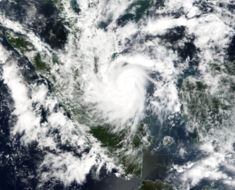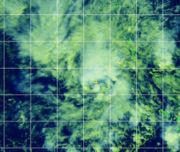Tropical Storm Vamei
2007 Schools Wikipedia Selection. Related subjects: Storms
| Tropical storm ( JMA) | |||
|---|---|---|---|
| Category 1 typhoon ( SSHS) | |||
|
Typhoon Vamei shortly before landfall |
|||
| Formed | December 26, 2001 | ||
| Dissipated | January 1, 2002 | ||
| Highest winds |
|
||
| Lowest pressure | 1006 mbar ( hPa) | ||
| Damage | Minor | ||
| Fatalities | 0 | ||
| Areas affected |
Singapore, Malaysia, Indonesia | ||
| Part of the 2001 Pacific typhoon season 2001 North Indian cyclone season |
|||
Tropical Storm Vamei (international designation: 0126, JTWC designation: 32W, sometimes called Typhoon Vamei; formerly had the alternate name Tropical Storm 05B) was the 26th named storm of the 2001 Pacific typhoon season. When it developed at 1.5° North, it earned the record for the storm that developed closest to the equator, breaking the record of Typhoon Sarah in 1956. In addition, Vamei became the only tropical cyclone in history to strike near Singapore when it hit the area in late December. Vamei crossed Indonesia and reformed in the North Indian Ocean, lasting until early the next year. The typhoon is named after a songbird with white feathers, popular to feeders in Macau.
Storm history
An area of convection 230 miles (370 km) east of Singapore developed from a monsoon trough disturbance under upper level divergence near the equator on December 25. It tracked westward, quickly organizing into Tropical Depression 32W on December 26 at only 1.4º north. An extremely small system, it continued to organize, and reached tropical storm strength that night only 104 miles (170 km) from the equator. Vamei's windfield was nearly cyclostrophic in nature, meaning it didn't rely on the coriolis effect to develop. Instead, it resembled a Meso-convective scale system.
With well-defined outflow on both sides of the equator and a developing eye, the Joint Typhoon Warning Centre declared that Vamei had reached typhoon strength early on December 27, only 12 hours into its existence. Upper-level steering flow forced the storm westward, where the compact system reached a ship-reported peak of 87 mph sustained winds and gusts reaching 120 mph, just hours after being designated a typhoon by the JTWC. At this time, the storm was only 170 miles (280 km) across, with strong winds confined to a 40 miles (65 km) radius.
Later on December 27, Vamei made landfall on the southeastern part of the Malay Peninsula, about 35 miles (60 km) northeast of Singapore. It weakened over the peninsula, and emerged into the Straits of Malacca as a weakening tropical storm. Upper level diffluence caused Vamei to retain its convection, but the mountainous terrain caused it to continue to weaken. On December 28 it made landfall in Sumatra, and further degraded to a tropical depression. Operationally, Vamei was declared dissipated over Sumatra on December 28.
Upon reaching the Indian Ocean on December 29 the remnants of Vamei re-organized, and on December 30, it became Tropical Cyclone 5B. Operationally, the remnants were declared a new system, but because postseason analysis indicated Vamei's circulation survived over Sumatra, it was re-classified as a continuation of the system. Late on December 30, Vamei became a tropical storm again, but strong mid- to upper level southwesterly winds greatly weakened the storm. Vamei lasted until the new year, but succumbed to the shear and dissipated on January 1.
Unusual formation
Vamei formed and reached tropical storm strength at 1.4º North, only 97 nautical miles (160 km) from the equator. The previous closest storm was Typhoon Sarah of the 1956 Pacific typhoon season, which reached tropical storm strength at 2.2ºN. Cyclone Agni in the 2004 North Indian cyclone season broke Vamei's record for the closest-existing tropical cyclone to the equator, at 0.7ºN or only 48 miles (78 km) from the equator. However, Vamei's formation was still further south than Agni's, and it remains the tropical cyclone formation closest to the equator. Vamei's crossing from the Western Pacific into the Bay of Bengal was also a relatively rare phenomenon.
Due to a lack of Coriolis effect near the equator, Vamei's formation startled many experts. Vamei formed because of two systems that happened to be interacting with each other; a circulation centre that formed near Borneo as well as a strong surge of winds, which created the spin and rotation of Vamei. However, as these occur often, questions were raised about why more equatorial storms fail to form in the South China Sea. It was determined that the terrain of the area puts a time constraint on such storms to form, hence not many do. It has been estimated that such perfect conditions will not repeat for another 100 to 400 years.
Impact
Because Vamei was a very small system, its effects were relatively minor, with no reported casualties. The majority of what little damage occurred involved ships that were caught off guard by the unexpected power of the storm. Storm surge damage was also reported in the southern Malay Peninsula, while two U.S. Navy ships were damaged by Vamei. Upon moving through Singapore and southern Malaysia, it brought heavy rain and flooding. Uprooted trees were seen in Vamei's path, but little other damage occurred. In addition, air traffic was disrupted at the airport in Singapore. Traffic jams occurred from the slick roads, but the storm was downplayed as a "low pressure system". Indeed, the Japan Meteorological Agency's Typhoon Centre, the official warning agency for the Western North Pacific west of the International Date Line and north of the equator, only classified Vamei as a tropical storm. Overall, effects were minimal.
Retirement
Because of a unique formation and track, the name Vamei was retired and replaced with Peipah.


